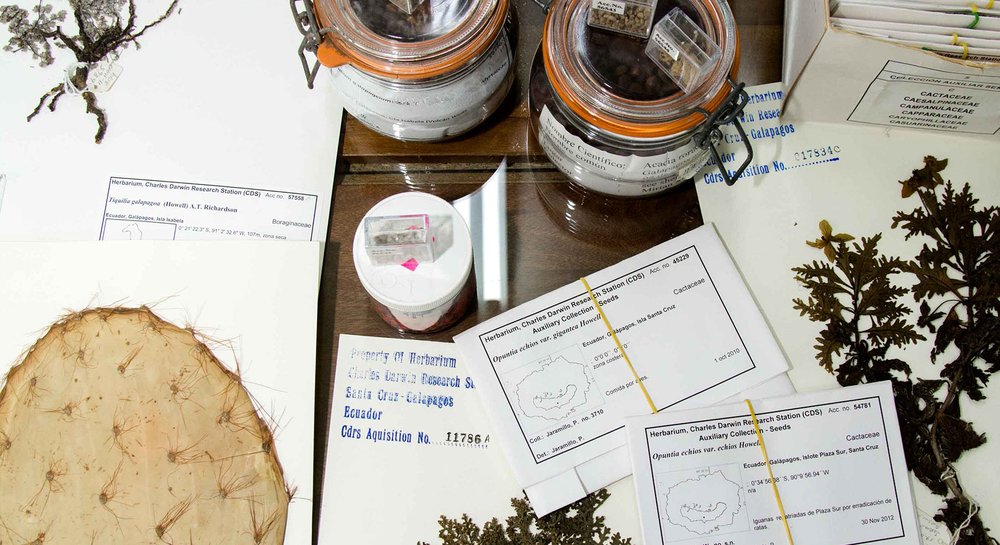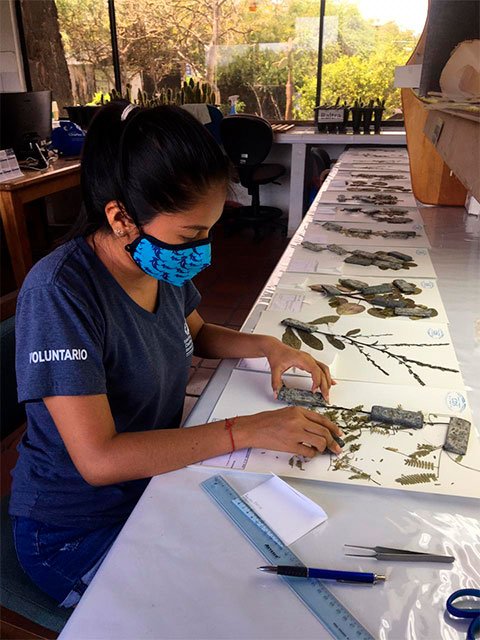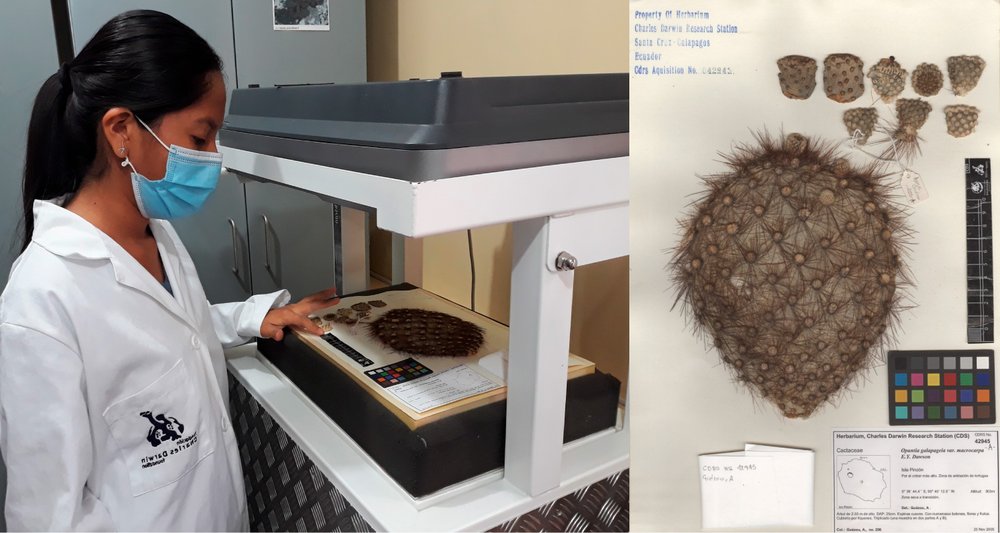
Author: Tania Mechelle Villafuerte LLugsa
The Charles Darwin Research Station (CDRS) is recognized for its work in science and research. These qualities were precisely what, from a young age, made me interested in becoming part of this great family. I am currently a student at the Universidad Técnica Particular de Loja, studying a degree in Environmental Management. Here I had the opportunity to take part in a project recording endemic plants on Santa Cruz Island and investigating their role in our community’s daily life. It was from that moment that I was riveted in exploring the world of botany.
In September 2020, amid the covid19 pandemic, I had the opportunity to become involved as volunteer in the research at the CDRS Herbarium. It was at that point that I began to learn what an herbarium is and what it can be used for. In summary, it is a library of dried plants, algae, fungi and lichens, each their own specimen.
The CDRS Herbarium contains endemic and introduced species that represent the botanical diversity of the Galapagos. They are a good representation of the total known flora and those species that highlight the archipelago’s unique diversity. Upon my arrival at the collection, I was so impressed to see thousands of plant specimens, carefully organized and stored. At first glance they all appeared to be the same. However, after observing them closely and studying them, I began to notice how they all differ. Botany offers us an almost infinite world of biodiversity to learn about! In that moment I knew I had started a journey of learning and supporting the CDRS herbarium, the largest collection of plants in the Galapagos islands.
Once I started working there I understood that within this wondrous collection of plants, there were dry organisms, but these were full of life, and history! I further learned that the herbarium contains several ancillary collections of plant parts:
A great experience I had was my first field trip, with Sarita Mahtani-Williams (Herbarium Assistant Taxonomist), Patricia Jaramillo Díaz (Herbarium Curator and Natural History Collections Coordinator) and Anne Guézou (Botanist at the CDRS). During this trip, we collected specimens for the CDRS herbarium’s collections. This experience was particularly interesting for me, as from a young age my parents had taught me Galapagos plants and I had learned their common names. And there I was, in the field, collecting plants with professional experts! I realized that they, on the other hand, referred to plant species by their scientific name. One way I started learning was realizing each species has a name and a surname, just like we do. For instance Justicia galapagana, of the Spanish common name “purple fly”, and Cordia lutea, known locally as “muyuyo”.
After that, I must confess that I have set myself a personal challenge: to learn the scientific names of most endemic plants of the island.
Following this field trip, I am proud to see that the first plants I collected are now together with specimens collected by famous scientists, contributing towards the CDS herbarium collection growth. During my time as a volunteer I have also learned that each collected plant must undergo its process before forming part of this world of dry specimens. Each specimen is identified, curated and mounted to ensure its long-term conservation. This last process, plant mounting, is my favourite part. At first, I found it rather difficult, but with time and daily practice I developed techniques to improve my results and work faster, it is certainly an art! This is the kind of work that, carried out over decades, has made the plant collection grow to what is now more than 46,000 specimens, which are and will continue to be used to deepen knowledge of the archipelago’s flora and support its conservation.

Among the daily tasks that are carried out in the CDRS herbarium, of great importance is the daily monitoring of temperature and humidity levels in the collections. This ensures that the atmospheric conditions are maintained at optimal levels to ensure the preservation of all herbarium specimens. This makes me realise that we are constantly looking after this diverse reservoir of plants, crucial for current and future studies.
Did you know that the CDRS herbarium runs projects that contribute towards scientific research?
In addition to the conservation and preservation of seeds, fruits, pollen, wood, and of course, entire plants, the CDRS Herbarium is also a place where scientific research is carried out. A useful tool for this, for example, is the digitization of mounted specimens of vascular plants, using the “HerbScan” scanner (Jaramillo et al., 2020). This project began in January 2015 and by now approximately two thirds of the collection have been digitized. The importance of this project for science became particularly clear in times of the pandemic. The quarantine period during 2020 fully highlighted the importance of having a virtual repository of such a vital natural history collection. And we know that thanks to technology such as this we will be able to achieve this goal! Additionally, our daily works includes updating our database, which also gives virtual access to information on all the species in the CDRS Herbarium collection via the digital repository called “dataZone” (https://www.darwinfoundation.org/en/datazone/checklist). This platform is accessible to anyone in the world interested in species of the Galapagos. What do you think? Isn’t it fantastic?

I can now say that working as a volunteer at the CDF has been one of my best lifetime experiences. During all this time I have been learning about and supporting the conservation of plant diversity of the Galapagos Islands. Within the degree I am pursuing, and thanks to the opportunity of carrying out my university practical internship in the herbarium, this experience has helped me understand my career interests. I am now more certain of how to plan where I want to go, decide what I want to do, and know who I want to be.
It is very rewarding to see how permanent residents of Galapagos, along with national and international researchers, contribute in their way to the growth and to the preservation of the CDRS herbarium collections for scientific use. I am proud to be able to help and learn from Sarita Mahtani-Williams, Patricia Jaramillo Díaz and Anne Guézou, professionals in the botanical field at the CDF. While working with them I have grown as a student, as a professional, and personally, and now see the world of botany as an irreplaceable jewel that we must conserve.
I now know that all this incredible work is made possible thanks to the support of generous donors NatGeo Lindblad Expeditions and Ecoventura who contribute to the maintenance of the Natural History Collections of the CDF. A special thank you to our Director of Sciences María José Barragán, to Sarita Mahtani-Williams and to Patricia Jaramillo Díaz for their valuable comments in writing this blog and to Sarita Mahtani-Williams for translating the Spanish version.
References:
Jaramillo, P., Acurio, A., Betancourt, L., Jiménez-uzcátegui, G., & Mahtani-Williams, S. (2020). Informe Anual para Renovación Patente Colecciones de Historia Natural. In Estación Científica Charles Darwin.





